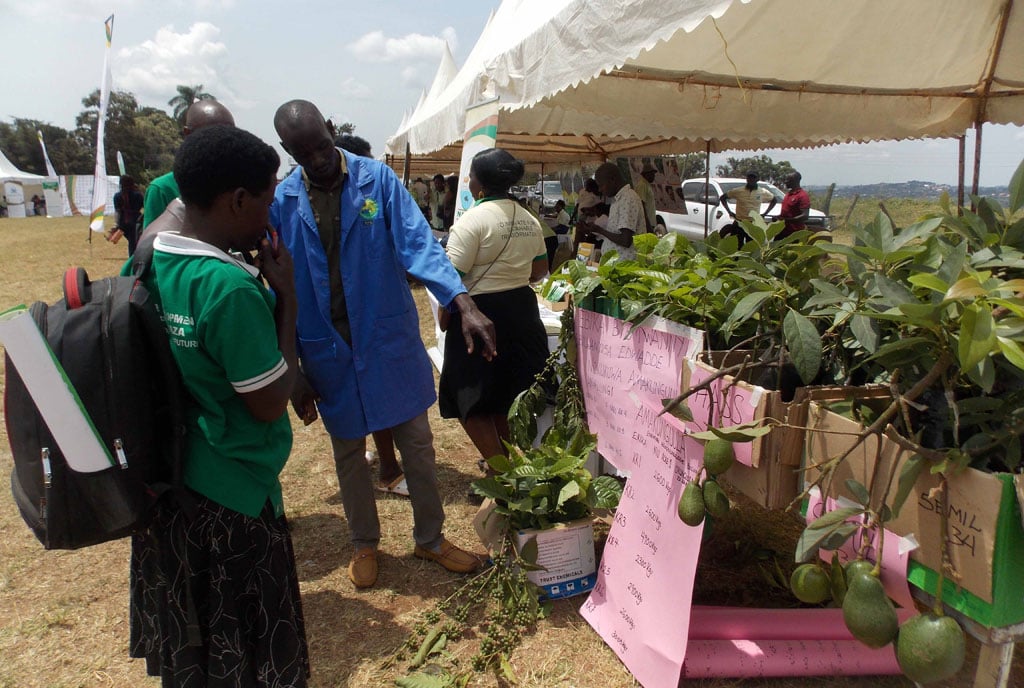Prime
Farmers learn how to plant ahead of the rainy season

A stall attendant (in blue coat) explains a point to show goers. PHOTO/MICHEAL J SSALI
What you need to know:
- Farmers were told to make planting holes at spacing of 75cm by 50cm during seed bed preparation.
- The soils should be moist at the time of planting and one bottle top of DAP/NPK should be applied per hole.
- It was further advised that three seeds should be planted per hole.
Farmers in the Greater Masaka Sub-region attended a seed show organised by the National Agricultural Research Organisation (Naro) and various seed companies ahead of the rainy season expected to begin in the next few weeks.
The seed show was held in Masaka City last Friday and it was an opportunity for the farmers to learn about recently introduced quality seed varieties and to be enlightened about safe planting instructions for the seeds.
New technology
Dr Barbra Mugwanya Zawedde, the head of Mukono Zonal Agricultural Research and Development Institute (MuZARDI) who represented the director general of Naro said the show was intended to enhance farmers’ knowledge about new agricultural technologies in the wake of climate change and related challenges.
“Banana production in this region for example has declined but we believe that the farmers can be assisted with the necessary information to overcome such a problem,” she told the show goers.
Good seed selection
Successful crop production starts with good seed selection. And as the rain season gets closer there could not be a better time than this for farmers to meet with the producers of improved seeds and especially to get some understanding about why they should opt for particular seeds.
Agro-Genetic Technologies (AGT) which uses biotechnology through tissue culture techniques to propagate different crops had a stall at the show.
Tissue culture plantlets
Farmers had the opportunity to view tissue culture plantlets of different crops such as banana, coffee, cassava and pineapples among others and to make orders.
The stall attendants gave out brochures and leaflets bearing the advantages of using tissue culture plantlets which include consistency and uniformity of quality crops produced in a specific period of time.
Disease-free
They are proven to be disease-free at the time of planting and, with appropriate farming practices, they all reach maturity and bear fruit at approximately the same time and in the required quantity. There is assurance that they are the same as the mother plant. The arrival of climate change has made farming a lot harder since now smallholders are faced with such issues as prolonged drought, and hitherto unknown pests and diseases some which have no known chemical cure. Naro has been collaborating with some seed companies and farmers’ organisations to produce drought tolerant seeds which were displayed at the various stalls of the show.
Controlling diseases
They included various bean and maize varieties. Some seeds were bred to be fast maturing or for superior yields while others were bred to be more nutritious. Farmers also had a chance to learn more about the new efforts that Naro is making in biotechnology to fix the issue of incurable crop diseases such as Banana Bacterial Wilt (BBW), which is reducing banana production, Late Blight, which is stifling Irish potato farming, sweet potato weevil, which has reduced production of the food crop, and Cassava Brown Streak Disease, which is killing off entire fields of the crop. Show goers also learnt about the effort that Naro is making to overcome common rice pests and diseases as well as soil related stress that is hampering rice production.
Agronomy
Naseco Seeds, a seed company, demonstrated to show goers safe use and planting instructions of maize seeds treated with strigAway. They were told to make planting holes at spacing of 75cm by 50cm during seed bed preparation. The soils should be moist at the time of planting and one bottle top of DAP/NPK should be applied per hole. It was further advised that three seeds should be planted per hole. Labour costs can be minimised by the use of selective pre-emergence herbicide to ensure weed free maize fields.
How to apply manure
Farmers were also however advised to apply farm yard manure if they want to during land preparation. They were further told that on germination the young plants will be yellowish, which is a sign that Strigaway is active and that within just a few weeks they will all become green. Farmers were also told to dress with Urea at six-leave-height of the maize plant.
Uganda is challenged not only to grow enough food for its population, estimated to be already close to 50 million, but also to come up with nutritious food, given that according to Unicef, more than one third of all young children –2.4 million—are stunted and half of children under five and one quarter of childbearing-age women are anaemic. Bio Crops (U) Ltd was at the show with demonstrations of tissue culture plantlets of orange fleshed sweet potato and other plantlets. Bio-fortified, or orange fleshed, sweet potato is known to be rich in Vitamin A and is highly recommended by the Ministry of Health for pregnant women to eat. Bio Crops (U) also had tissue culture plantlets for coffee, cassava, and banana.
Hybrid seeds
Uganda Prisons Service, under the banner “Plant Hybrid Maroons Maize seeds double-double cobber” also breeds maize seeds that were available at the show. The stall attendant, Alex Kazibwe assured show goers that, under good management, their seed maize varieties give yields of between 40 and 45 bags per acre. At the stall were available, UH5355 (maroon), Longe 5D (Open Pollinated), and UH55051 (Uganda Hybrid).
Kamenyamiggo Agricultural Institute which is under MuZARDI displayed cuttings for Hass Avocado and Robusta coffee among other items.
Uganda Coffee Development Authority (UCDA) also had a stall at which farmers were educated about the Coffee Wilt Disease (CWD) resistant lines whose attributes include good cup quality, resistance to leaf rust, and big coffee beans. At the UCDA stall farmers were also drilled in fighting Coffee Berry Disease and Black Coffee Twig Borer (BCTB). Farmers further learnt that BCTB is actually a beetle that also attacks other plant species such as tomatoes, passion fruit among others.
There was also a Uganda Biotechnology Information Centre (UBIC) stall at which show goers were told the meaning of biotechnology and its contribution to the development of agriculture.
Training
Labour costs can be minimised by the use of selective pre-emergence herbicide to ensure weed-free maize fields. Farmers were also, however, advised to apply farm yard manure if they want to during land preparation.
They were further told that on germination the young plants will be yellowish, which is a sign that StrigAway is active and that within just a few weeks they will all become green.




